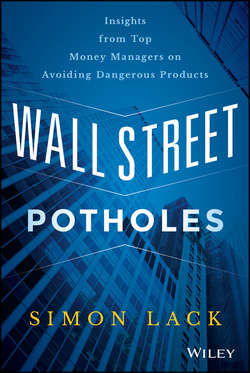Читать книгу Wall Street Potholes - Simon А. Lack - Страница 11
На сайте Литреса книга снята с продажи.
Chapter 1
Non-traded REITs: A Security That Shouldn't Exist
Overall Returns Are Poor
ОглавлениеThere is a 2012 study (Reuters 2014) by Blue Vault Partners and the University of Texas that analyzed the start-to-finish returns on 17 non-traded REITs. They found that the internal rate of return (a type of investment return that reflects inflows and outflows on multiple dates) was just over 10 %. That sounds good, except that over the same time, publicly traded REITs performed 1 % or so better.
Another study carried out by Securities Litigation and Consulting Group (Wall Street Journal 2014), a research company based in Fairfax, Virginia, compared 27 non-traded REITs that had gone through a full cycle from raising capital to returning the proceeds to investors. Their study covered a period of more than 20 years, from June 1990 to October 2013. They found that after fees investors earned 5.2 %, compared with the Vanguard REIT Index Fund (a mutual fund) of 11.9 %. So in exchange for no liquidity, higher fees, and generally fewer safeguards, investors earned a lower return. Private equity investors expect returns above those available in the public equity market, as compensation for the additional risks involved. An additional return of 3 % to 5 % is not an uncommon requirement, meaning that if a chosen equity index such as the Russell 2000 returns 10 % during the time period that the private equity investor held his investments, he would expect to have earned 13 % to 15 % or more. Otherwise, the choice of private equity was not worth the risk compared to its more liquid publicly traded equivalent.
There's a saying on Wall Street that certain investments are sold, not bought, in that they require a salesman to push them on a willing investor rather than the buyer actively seeking them out. This would certainly apply to non-traded REITS. Because the first question any investor, or for that matter well-intentioned advisor, should ask before considering non-traded REITs is how the sector is likely to perform going forward. Asset allocation, the choice of how much an investor should put in stocks, investment grade bonds, REITs, high-yield bonds, commodities, or any other asset class generally drives 80 % to 90 % of the investor's overall return. In other words, assuming you hold a reasonably diversified portfolio and don't bet heavily on just a few investments, if stocks are up 10 % you should be up by a similar amount. Of course it's a generalization, but the point is that the biggest decision an investor makes is how much to allocate to an asset class.
So before even considering an individual non-traded REIT, you need to consider how the sector is likely to perform and how this compares with the other assets available to you. This is how institutional investors start their investment process. Given the limited amount of data available for non-traded REITs and the unsophisticated investor base, it's unlikely this basic question receives any attention. It also means that investors are unlikely to properly evaluate the performance of a non-traded REIT once they've bought it. Unless you're in finance for a living, comparing results with a benchmark won't come naturally.
